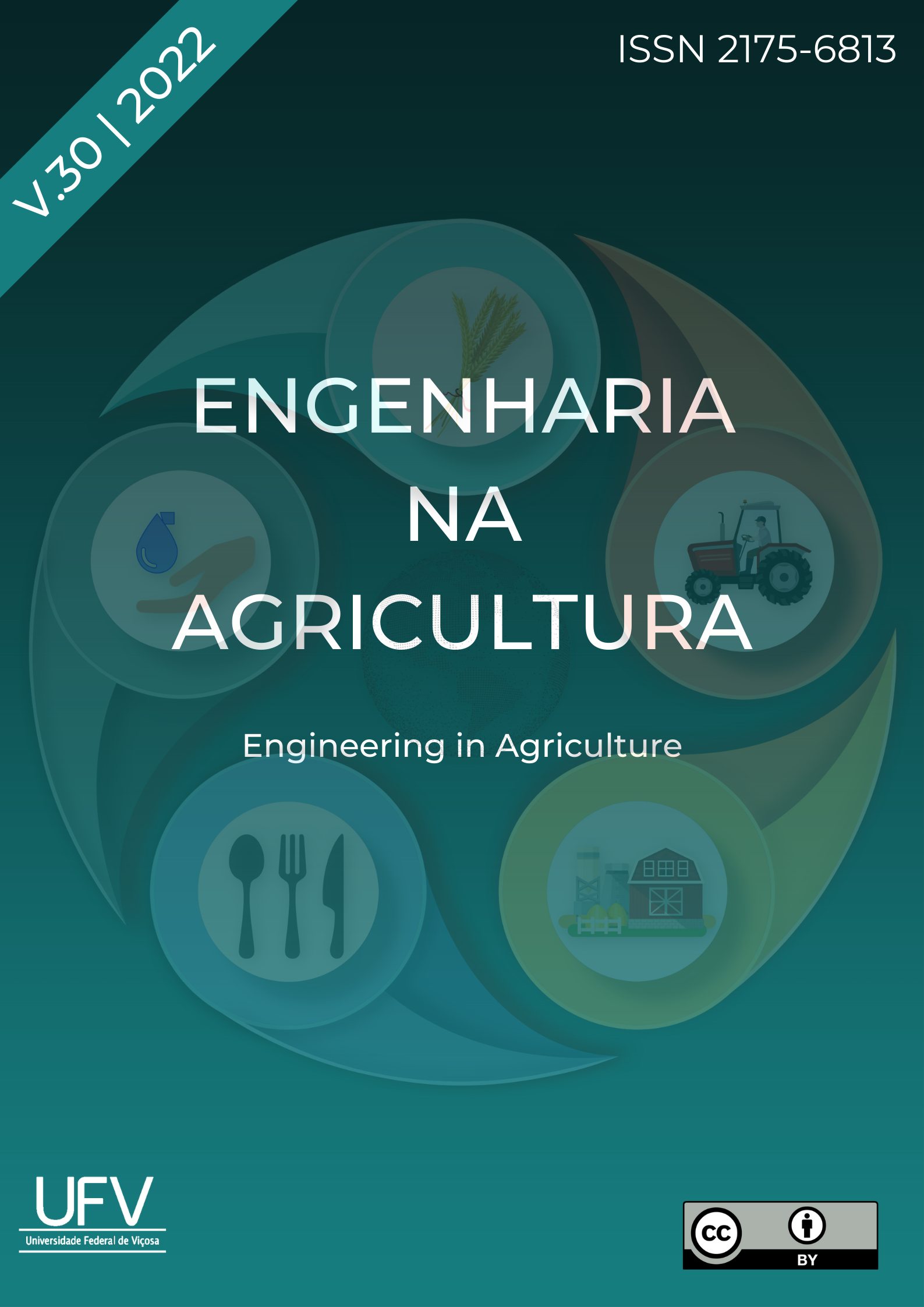Analysis of pest incidence on apple trees validated by unsupervised machine learning algorithms
DOI:
https://doi.org/10.13083/reveng.v30i1.12919Palavras-chave:
Pest management, Geostatistics, Unsupervised Machine Learning, Orchards, ApplesResumo
Integrated pest control is a practice commonly used in apple orchards in southern Brazil. This type of management is an important tool to help improve quality and increase yields. This study aimed to identify areas with higher and lower incidence of aerial pests in a commercial apple orchard, regarding data collected from three different crops using georeferenced traps. Geostatistical analyses were performed, based on the modeling of semivariograms and spatial interpolation using the kriging method; and clustering, based on specific unsupervised machine learning algorithms for count data. The algorithms were selected from measures of stability, connectivity and homogeneity, seeking to identify areas with different incidence of pests that could help farmer decision making regarding insect population control using pesticides. The geostatistical analysis verified the presence of individual pest infestations in specific sites of the study area. Additionally, the analysis using machine learning allowed the identification of areas with incidence above the average for all analyzed pests, especially in the central area of the map. The process of evaluation described in this study can serve as an aid for risk analysis, promoting management benefits and reducing cost in the farms.
Downloads
Referências
BONIECKI, P.; KOSZELA, K.; PIEKARSKA-BONIECKA, H.; WERES, J.; ZABOROWICZ, M.; KUJAWA, S.; MAJEWSKI, A.; RABA, B. Neural identification of selected apple pests. Computers and Electronics in Agriculture, Amsterdam, v. 110, p. 9-16, 2015.
BRUNELLI, D.; ALBANESE, A.; D’ACUNTO, D.; NARDELO, M. Energy neutral machine learning based iot device for pest detection in precision agriculture. IEEE Internet of Things Magazine, [s.l.], v. 2, n. 4, p. 10-13, 2019.
CANDEIA, M. G.; GEBLER, L.; BUENO, M. B. Uso da AP no gerenciamento de metadados de longo prazo de monitoramento de pragas da macieira. In: CONGRESSO BRASILEIRO DE AGRICULTURA DE PRECISÃO – CONBAP, 2016, Goiânia. Anais [...]. Goiânia: Sociedade Brasileira de Engenharia Agrícola, 2016.
Dinardo-Miranda, L. L.; Vasconcelos, A. C. M.; Veira, S. R.; Fracasso, J. V.; Grego, C. R. Uso da geoestatística na avaliação da distribuição de Mahanarva fimbriolata em cana-de-açúcar. Bragantia, Campinas, v. 66, p. 449-455, 2007.
FIORAVANÇO, J. C.; DOS SANTOS, R. S. S. (Ed.). Maçã - o produtor pergunta, a Embrapa responde. Brasília: Embrapa, 2013.
JAIN, A. K.; DUBES, R. C. Algorithms for clustering data. Hoboken: Prentice-Hall, 1988.
JENKS, G. F. The data model concept in statistical mapping. International yearbook of cartography, [s.l.], v. 7, p. 186-190, 1967.
KOVALESKI, A.; RIBEIRO, L. G. Manejo de pragas na produção integrada da maçã. Bento Gonçalves: Embrapa Uva e Vinho, 2002.
LAZZAROTTO, J. J. Indicadores econômicos e financeiros em sistemas típicos de produção de maçã no Brasil. Bento Gonçalves: Embrapa Uva e Vinho, 2018.
MCHUGH, M. L. Interrater reliability: the kappa statistic. Biochemia medica, Zagreb, v. 22, n. 3, p. 276-282, 2012.
MOON, T. K. The expectation-maximization algorithm. IEEE Signal processing magazine, [s.l.], v. 13, n. 6, p. 47-60, 1996.
PROTAS, J. F. S.; SANHUEZA, R. M. V. Normas Técnicas e Documentos de Acompanhamento da Produção Integrada de Maçãs. Bento Gonçalves: Embrapa Uva e Vinho, 2002.
QGIS. A Free and OpenSource Geographic Information System. Available in: https://qgis.org. Access in: July 26, 2021.
ROGGIA, S.; BUENO, A. de F.; OLIVEIRA, M. C. N. de; GREGO, C. R.; VICENTE, A. K.; VICENTE, L. E. Controle localizado. Cultivar Grandes Culturas, v. 21, n. 263, p. 24-28, 2021.
SEKULA, M.; DATTA, S.; DATTA, S. OptCluster - An R package for determining the optimal clustering algorithm. Bioinformation, [s.l.], v. 13, n. 3, p. 101, 2017.
SI, Y.; LIU, P.; LI, P.; BRUTNELL, T. P. Model-based clustering for RNA-seq data. Bioinformatics, Oxford, v. 30, n. 2, p. 197-205, 2014.
UEDA, N.; NAKANO, R. Deterministic annealing EM algorithm. Neural networks, [s.l.], v. 11, n. 2, p. 271-282, 1998.
VAN LAARHOVEN, P. J. M.; AARTS, E. H. L. Simulated annealing: Theory and applications. Dordrecht: Springer, 1987.
VIEIRA, S. R.; GARCIA, M. A. G.; GONZÁLEZ, A. P.; SIQUEIRA, G. M. Variabilidade espacial e temporal do teor de água do solo sob duas formas de uso. Bragantia, Campinas, v. 69, n. 1, 2010
VIERA, A. J.; GARRETT, J. M. Understanding interobserver agreement - The kappa statistic. Fam med, Leawood, v. 37, n. 5, p. 360-363, 2005.
WITTEN, I. H.; FRANK, E.; HALL, M. A. Data Mining: Practical Machine Learning Tools and Techniques. 3rd ed. London: Morgan Kaufmann, 2011.
WRZESIE?, M.; TREDER, W.; KLAMKOWSKI, K.; RUDNICKI, W. R. Prediction of the apple scab using machine learning and simple weather stations. Computers and Electronics in Agriculture, Amsterdan, v. 161, p. 252-259, 2019.
Downloads
Publicado
Como Citar
Edição
Seção
Licença
Copyright (c) 2022 Revista Engenharia na Agricultura - REVENG

Este trabalho está licenciado sob uma licença Creative Commons Attribution-NonCommercial 4.0 International License.
Autores que publicam nesta revista concordam com os seguintes termos:
O(s) autor(es) autoriza(m) a publicação do texto na da revista;
O(s) autor(es) garantem que a contribuição é original e inédita e que não está em processo de avaliação em outra(s) revista(s);
A revista não se responsabiliza pelas opiniões, ideias e conceitos emitidos nos textos, por serem de inteira responsabilidade de seu(s) autor(es);
É reservado aos editores o direito de proceder a ajustes textuais e de adequação às normas da publicação.
A partir da submissão, o autor estará cedendo integralmente seus direitos patrimoniais da obra à publicação, permanecendo detentor de seus direitos morais (autoria e identificação na obra) e de acordo com a Licença Creative Commons, CC BY-NC.








 Esta obra está licenciada com uma Licença
Esta obra está licenciada com uma Licença 